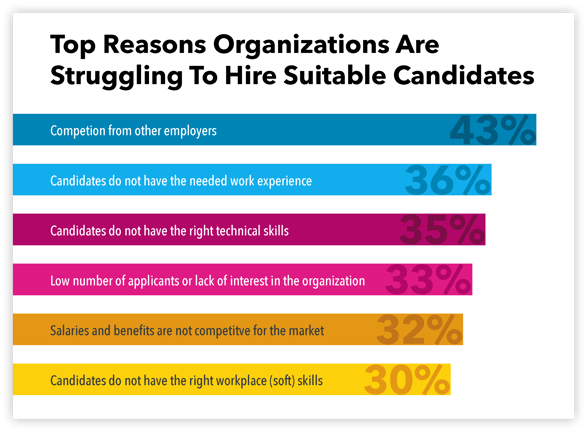How Digital Workflow Automation Mitigates Staffing Challenges and Boosts Efficiency
Is your organization feeling the effects of pandemic-era staffing shortages? If so, you're not alone.

Businesses in nearly every industry are ready to bounce back from COVID-related slowdowns, but bringing in qualified new team members to support their growth is often easier said than done. At the same time, leadership teams want to invest in tech-based solutions to accelerate their digital transformations and equip their workforce for post-pandemic success.
Digital workflow automation is emerging as a multi-pronged solution to both challenges by supplementing certain members of the workforce with automated software. In fact, ninety percent of executives expect their automation investments to increase their workforce capacity over the next three years.
In this post, we'll share several signs you might be ready to automate certain business processes and highlight the benefits of a right-fit workflow automation solution.
When Is It Time to Consider Digital Workflow Automation?
#1 Your business is growing or expanding its services.
An increase in revenue doesn't always mean an increase in internal staffing budgets, which leaves managers to "do more with less," even as demands grow or services expand. If you're looking for ways to support business growth or spikes in consumer demand, keep in mind that hiring more employees isn't your only option.
Workflow automation can help you grow your operations without restructuring your existing teams or adding headcount to your workforce. Implementing automation software reduces the strain on your short-term staffing investment and paves the way for long-term scalability since it can be customized and expanded over time.
#2 It's challenging to source and hire qualified talent.

Employers across industries have felt the effects of pandemic-era staffing shortages. Most notably, skill deficits in tech and
other high-demand fields have left organizations searching for candidates who are truly qualified to fill open roles. Even when you find the right person for the job, you may not have room on the books to meet their salary expectations.
Seventy-five percent of hiring managers credit hiring challenges to skill shortages.
Digital workflow automation streamlines once-manual tasks like filing, system backups, and more, which will reduce your staffing needs across departments. What's more, eliminating the need for an entry-level employee to complete these tasks allows you to allocate more of your staffing resources to the specialists you need to execute complex processes and projects.
#3 Your existing workflows are inefficient or outdated.
As your business evolves, the legacy processes that once defined your operations may stop supporting your staff effectively. These inefficiencies could be obvious, like if you're late on vendor invoices every month, or they might be more subtle and cause employees to waste several minutes here and there. Either way, inefficient workflows slow down your business and burden your workforce with frustrating, unnecessary tasks.
If you notice recurring communication challenges, dips in team productivity, or process-related complaints from your staff, it's likely time to re-assess your business workflows. The right automation software can help you establish workflows that relieve teams of tedious tasks and increase office productivity in several departments—by speeding up pay cycles, improving data management, or simply reducing your employees' administrative lift.
Which Tasks Should You Automate?
For some, the term "automation" evokes visions of robot-powered assembly lines or bleeding-edge technology that completely transforms operations. However, automation has the power to improve core business workflows and make significant behind-the-scenes impacts in nearly any business. Businesses across industries use automation to:
- Streamline data entry, including imports, exports, and data quality management.
- Send, manage, and follow up on incoming and outgoing invoices.
- Schedule social posts, send time-sensitive emails, and publish content online.
- Store, update, and retrieve digital documents across locations and devices.

Fifty-seven percent of respondents to a recent McKinsey & Co. survey say their organizations are at least piloting the automation of processes in one or more departments.
Workflow automation is all about identifying repeatable processes and replacing manual approaches with automatic, technology-enabled alternatives. As you consider where and how to automate, consider everything you and your team do each day. Start by asking your employees and managers questions like:
- What are the most common recurring tasks in your role? How often do you complete them?
- Which tasks are the most time-consuming, tedious, or frustrating to complete?
- What gaps do you see in our existing processes?
- Are there tasks you often miss or forget to do when working on a project?
Think about the tasks your teams repeat most often, especially those with multiple steps. Examples include following up with clients on invoices, generating performance reports, or updating data in a series of spreadsheets. Bonus points if these workflows always follow a pre-defined checklist or framework.
Be sure you also capture the "mindless" to-do list items that tend to build up over time, like that data entry task that only takes a few minutes each day. These tasks may not feel like a significant lift in the short term, but they can pull your employees away from high-value, customer-facing initiatives over time.
Adopt a Right-Fit Workflow Automation Solution with UBEO
No matter where or why you choose to automate business workflows, it's essential to find software that can support your needs now and in the future. You'll need to find a solution that can scale with your operations, integrate with your existing systems, and meet your employees' needs day in and day out.
Steer clear of one-off software vendors that will sell you a single tool, then leave your IT team to implement and configure it themselves. Instead, look for a trustworthy partner that assesses your entire work environment and recommends holistic, scalable solutions.
At UBEO, we know there's no one-size-fits-all approach to workflow management. That's why we conduct a deep dive into your organization to identify the best technologies and processes to support your goals and empower your teams to do great work.
We partner with you from initial investment through ongoing support to ensure the digital workflow automation solutions we implement serve you and your employees effectively. We'll help you maximize your existing software investments and adopt new solutions that boost efficiency, reduce obstacles, and pave the way for ongoing success.
Contact our team today to discover how our custom business technology solutions can transform your organization.
Jeremy Francis
I am passionate about providing excellent customer care, building relationships based on trust, and delivering results that benefit the customer and the business as a whole.



